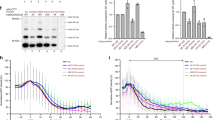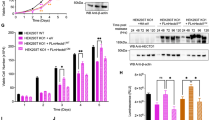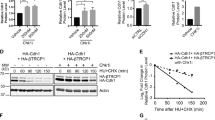Abstract
Ubiquitin-mediated proteolysis due to the anaphase-promoting complex/cyclosome (APC/C) is essential for separation of sister chromatids, requiring degradation of the anaphase inhibitor Pds1, and for exit from mitosis, requiring inactivation of cyclin B Cdk1 kinases1. Exit from mitosis in yeast involves accumulation of the cyclin kinase inhibitor Sic1 as well as cyclin proteolysis mediated by APC/C bound by the activating subunit Cdh1/Hct1 (APCCdh1)2,3. Both processes require the Cdc14 phosphatase, whose release from the nucleolus during anaphase causes dephosphorylation and thereby activation of Cdh1 and accumulation of another protein, Sic1 (refs 4,5,6,7). We do not know what determines the release of Cdc14 and enables it to promote Cdk1 inactivation, but it is known to be dependent on APC/C bound by Cdc20 (APCCdc20) (ref. 4). Here we show that APCCdc20 allows activation of Cdc14 and promotes exit from mitosis by mediating proteolysis of Pds1 and the S phase cyclin Clb5 in the yeast Saccharomyces cerevisiae. Degradation of Pds1 is necessary for release of Cdc14 from the nucleolus, whereas degradation of Clb5 is crucial if Cdc14 is to overwhelm Cdk1 and activate its foes (Cdh1 and Sic1). Remarkably, cells lacking both Pds1 and Clb5 can proliferate in the complete absence of Cdc20.
This is a preview of subscription content, access via your institution
Access options
Subscribe to this journal
Receive 51 print issues and online access
$199.00 per year
only $3.90 per issue
Buy this article
- Purchase on Springer Link
- Instant access to full article PDF
Prices may be subject to local taxes which are calculated during checkout




Similar content being viewed by others
References
Morgan,D. O. Regulation of the APC and the exit from mitosis. Nature Cell Biol. 1, E47–E53 (1999).
Visintin,R., Prinz,S. & Amon,A. CDC20 and CDH1: a family of substrate-specific activators of APC-dependent proteolysis. Science 278, 460–463 (1997).
Schwab,M., Lutum,A. S. & Seufert,W. Yeast Hct1 is a regulator of Clb2 cyclin proteolysis. Cell 90, 683–693 (1997).
Visintin,R. et al. The phosphatase Cdc14 triggers mitotic exit by reversal of Cdk-dependent phosphorylation. Mol. Cell 2, 709–718 (1998).
Jaspersen,S. L., Charles,J. F. & Morgan,D. O. Inhibitory phosphorylation of the APC regulator Hct1 is controlled by the kinase Cdc28 and the phosphatase Cdc14. Curr. Biol. 9, 227–236 (1999).
Shou,W. et al. Exit from mitosis is triggered by Tem1-dependent release of the protein phosphatase Cdc14 from nucleolar RENT complex. Cell 97, 233–244 (1999).
Visintin,R., Hwang,E. S. & Amon,A. Cfi1 prevents premature exit from mitosis by anchoring Cdc14 phosphatase in the nucleolus. Nature 398, 818–823 (1999).
Yamamoto,A., Guacci,V. & Koshland,D. Pds1p, an inhibitor of anaphase in budding yeast, plays a critical role in the APC and checkpoint pathway(s). J. Cell Biol. 133, 99–110 (1996).
Shirayama,M., Zachariae,W., Ciosk,R. & Nasmyth,K. The Polo-like kinase Cdc5p and the WD-repeat protein Cdc20p/Fizzy are regulators and substrates of the anaphase promoting complex in Saccharomyces cerevisiae. EMBO J. 17, 1336–1349 (1998).
Lim,H. H., Goh,P. Y. & Surana,U. Cdc20 is essential for the cyclosome-mediated proteolysis of both Pds1 and Clb2 during M phase in budding yeast. Curr. Biol. 8, 231–234 (1998).
Novák,B. et al. Finishing the cell cycle. J. Theor. Biol. 199, 223–233 (1999).
Mumberg,D., Mueller,R. & Funk,M. Regulatable promoters of Saccharomyces cerevisiae: comparison of transcriptional activity and their use for heterologous expression. Nucleic Acids Res. 22, 5767–5768 (1994).
Burns, N. et al. Large-scale analysis of gene expression, protein localization, and gene disruption in Saccharomyces cerevisiae. Genes Dev. 8, 1087–1105 (1994).
Riley,J. et al. A novel, rapid method for the isolation of terminal sequences from yeast artificial chromosome (YAC) clones. Nucleic Acids Res. 18, 2887–2890 (1990).
Schwob,E., Böhm,T., Mendenhall,M. D. & Nasmyth,K. The B-type cyclin kinase inhibitor p40SIC1 controls the G1 to S transition in S. cerevisiae. Cell 79, 233–244 (1994).
Cohen-Fix,O., Peters,J.-M., Kirschner,M. W. & Koshland,D. Anaphase initiation in Saccharomyces cerevisiae is controlled by the APC-dependent degradation of the anaphase inhibitor Pds1p. Genes Dev. 10, 3081–3093 (1996).
de Beus,E., Brockenbrough,J. S., Hong,B. & Aris,J. P. Yeast NOP2 encodes an essential nucleolar protein with homology to a human proliferation marker. J. Cell Biol. 127, 1799–1813 (1994).
Tinker-Kulberg,R. L. & Morgan,D. O. Pds1 and Esp1 control both anaphase and mitotic exit in normal cells and after DNA damage. Genes Dev. 13, 1936–1949 (1999).
Cohen-Fix,O. & Koshland,D. Pds1p of budding yeast has dual roles: inhibition of anaphase initiation and regulation of mitotic exit. Genes Dev. 13, 1950–1959 (1999).
Surana,U. et al. Destruction of the CDC28/CLB mitotic kinase is not required for the metaphase to anaphase transition in budding yeast. EMBO J. 12, 1969–1978 (1993).
Ciosk,R. et al. An Esp1/Pds1 complex regulates loss of sister chromatid cohesion at the metaphase to anaphase transition in yeast. Cell 93, 1067–1076 (1998).
Skowyra,D. et al. F-box proteins are receptors that recruit phosphorylated substrates to the SCF ubiquitin-ligase complex. Cell 91, 209–219 (1997).
Feldman,R. M., Correll,C. C., Kaplan,K. B. & Deshaies,R. J. A complex of Cdc4p, Skp1p, and Cdc53p/Cullin catalyzes ubiquitination of the phosphorylated CDK inhibitor Sic1p. Cell 91, 221–230 (1997).
Verma,R. et al. Phosphorylation of Sic1p by G1 CDK required for its degradation and entry into S phase. Science 278, 455–460 (1997).
Zachariae,W., Schwab,M., Nasmyth,K. & Seufert,W. Control of cyclin ubiquitination by CDK-regulated binding of Hct1 to the anaphase promoting complex. Science 282, 1721–1724 (1998).
Epstein,C. B. & Cross,F. R. CLB5: a novel B cyclin from budding yeast with a role in S phase. Genes Dev. 6, 1695–1706 (1992).
Schwob,E. & Nasmyth,K. CLB5 and CLB6, a new pair of B cyclins involved in DNA replication in Saccharomyces cerevisiae. Genes Dev. 7, 1160–1175 (1993).
Sherr,C. J. Mammalian G1 cyclins. Cell 73, 1059–1065 (1993).
Sigrist,S., Jacobs,H., Stratmann,R. & Lehner,C. F. Exit from mitosis is regulated by Drosophila fizzy and the sequential destruction of cyclins A, B and B3. EMBO J. 14, 4827–4838 (1995).
Wach,A. et al. Heterologous HIS3 marker and GFP reporter modules for PCR-targeting in Saccharomyces cerevisiae. Yeast 13, 1065–1075 (1997).
Acknowledgements
We thank J. Charles, D. Morgan, A. Amon and E. Schwob for sharing unpublished results; E. Kramer and J.-M. Peters for technical help; A. Amon, J. Aris, L. Huber, L. Guarente, D. Kellogg, and J. Kilmartin for gifts of antibodies; G. Ammerer for the transposon library; and F. Cross, Y. Kikuchi and W. Zachariae for comments on this manuscript.
Author information
Authors and Affiliations
Corresponding author
Rights and permissions
About this article
Cite this article
Shirayama, M., Tóth, A., Gálová, M. et al. APCCdc20 promotes exit from mitosis by destroying the anaphase inhibitor Pds1 and cyclin Clb5. Nature 402, 203–207 (1999). https://doi.org/10.1038/46080
Received:
Accepted:
Issue Date:
DOI: https://doi.org/10.1038/46080
This article is cited by
-
PLAGL1 is associated with prognosis and cell proliferation in pancreatic adenocarcinoma
BMC Gastroenterology (2023)
-
The increase in cell death rates in caloric restricted cells of the yeast helicase mutant rrm3 is Sir complex dependent
Scientific Reports (2023)
-
CDC20 promotes radioresistance of prostate cancer by activating Twist1 expression
Apoptosis (2023)
-
Polyanions provide selective control of APC/C interactions with the activator subunit
Nature Communications (2019)
-
Boolean gene regulatory network model of centromere function in Saccharomyces cerevisiae
Journal of Biological Physics (2019)
Comments
By submitting a comment you agree to abide by our Terms and Community Guidelines. If you find something abusive or that does not comply with our terms or guidelines please flag it as inappropriate.



